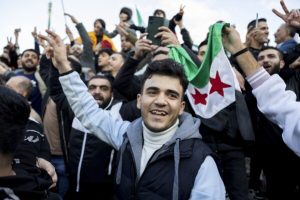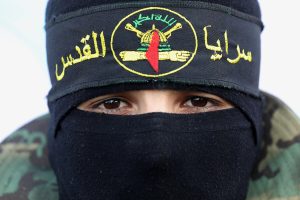Separatists in Syria: The Syrian conflict, now entering its fourteenth year, remains a festering wound on the Middle East, a brutal testament to the destructive interplay of local grievances, regional rivalries, and global power politics.
While the frontlines of major conventional warfare have largely calcified, the landscape is far from static. Significant movements and shifts continue beneath the surface, particularly in the resource-rich northeast and the volatile northwest, while the persistent specter of Israeli military aggression adds another layer of destabilization and profound suffering.
At the heart of the northeast’s complex equation lies the enduring challenge posed by Separatists in Syria, primarily the Kurdish-led Autonomous Administration of North and East Syria (AANES) and its military wing, the Syrian Democratic Forces (SDF).
Separatists in Syria: Separatist Ambitions and Entrenched Complexities
The territory east of the Euphrates, controlled by the AANES, represents the most significant deviation from the Syrian state’s pre-2011 borders.
Governed by a system emphasizing local autonomy, secularism, and women’s rights, the AANES project is fundamentally viewed by Damascus and key regional players like Turkey as a separatist endeavor threatening Syria’s territorial integrity.
The presence and influence of the Kurdistan Workers’ Party (PKK), designated a terrorist organization by Turkey, the US, and the EU, is the core reason for Ankara’s vehement opposition.
Turkey sees the AANES and SDF as nothing less than an existential threat, a Syrian extension of the PKK. you can read more bout it Here.
Recent months have witnessed heightened tensions and strategic maneuvering in this arena:
Turkish Threats Resurface: Ankara has repeatedly signaled its intent to launch a new major military incursion into northern Syria, targeting SDF-held areas, particularly around Tal Rifaat and Manbij.
While a full-scale operation has been delayed, partly due to US and Russian pressure and Turkey’s internal political calculus, the threat remains acute.
Turkish drones frequently target SDF positions and commanders, keeping the region in a state of constant alert. This pressure directly impacts the stability of areas governed by the Separatists in Syria.
Russia’s Shifting Calculus: Russia, while nominally supporting Damascus’s sovereignty, maintains pragmatic relations with the SDF, seeing them as a useful counterweight to Islamist groups and a means to secure its own interests (like oil fields) in the east.
However, Russia also balances this with its strategic partnership with Turkey. Recent reports suggest Moscow might be subtly encouraging dialogue between Damascus and the AANES,
albeit on terms heavily favoring the central government, aiming to gradually erode the autonomy project and reduce US influence. This puts the Separatists in Syria in a difficult bargaining position.
The US Dilemma: The US maintains around 900 troops in northeast Syria, partnered with the SDF, primarily focused on the enduring mission against ISIS remnants.
However, US commitment is perceived as increasingly uncertain. Policy debates in Washington, regional priorities shifting towards countering Iran and China, and the desire to avoid direct confrontation with Turkey create an environment of instability for the AANES.
The Separatists in Syria rely heavily on this US presence as a deterrent against Turkey and a tacit endorsement of their governance model.
Arab-Kurdish Friction: Beneath the surface of the AANES project lie unresolved tensions between Kurdish authorities and Arab tribes within their territory.
Issues of resource distribution (oil, water), perceived marginalization, property disputes, and the legacy of Arab tribal cooperation with ISIS occasionally flare into open conflict.
These internal fissures are exploited by Damascus, Ankara, and even ISIS to undermine the AANES’s legitimacy and control, challenging the cohesion of the Separatists in Syria.
ISIS Insurgency: Despite territorial defeat, ISIS cells remain active, particularly in the Syrian desert (Badiya) but also conducting hit-and-run attacks and assassinations in SDF-held areas.
This low-intensity insurgency drains SDF resources, destabilizes communities, and provides a justification for continued external military presence.
The Israeli Factor: Escalating Aggression and Blatant Violations
While the northeast grapples with its internal and external pressures, the entire country, particularly government-held areas, suffers under the relentless shadow of Israeli airstrikes.
Framed by Israel as necessary actions to prevent Iranian entrenchment and weapons transfers to Hezbollah in Lebanon, these strikes constitute a flagrant violation of Syrian sovereignty and international law.
The frequency and intensity of these attacks have arguably increased in recent months, marking a dangerous new phase:
Targeting Civilians and Infrastructure: Israeli strikes have repeatedly hit civilian airports (Damascus and Aleppo), residential areas, ports (Latakia), and vital infrastructure.
The toll on civilians is devastating, with numerous reports of non-combatant deaths, injuries, and widespread destruction of homes and livelihoods. This is collective punishment, plain and simple.
Expanded Scope: Strikes now frequently target locations far from the Lebanese border, deep within Syria, including near the Iraqi border and even in coastal regions, indicating a broader campaign to degrade Syrian state capabilities and Iranian influence wherever it is perceived.
Dangerous Escalation: Recent strikes have killed senior Iranian Revolutionary Guard Corps (IRGC) officers within Syria, significantly raising the stakes.
This deliberate targeting of foreign military personnel on sovereign Syrian territory dramatically increases the risk of a wider regional conflagration, potentially dragging in Lebanon’s Hezbollah and Iran directly.
The April 2024 attack on the Iranian consulate in Damascus (a clear violation of the Vienna Conventions) and the retaliatory Iranian drone/missile strike on Israel underscored how quickly Syrian territory can become the tinderbox for regional war.
Undermining Stability: Every Israeli strike further devastates Syria’s crippled economy, destroys critical infrastructure needed for any future recovery, and deepens the humanitarian catastrophe for a population already enduring unimaginable hardship.
It perpetuates a cycle of violence and retaliation that makes any political resolution even more distant.
The chaos created by these strikes can also indirectly create vacuums exploited by other actors, potentially impacting areas controlled by the Separatists in Syria.
The Tangled Web: Separatists, Israel, and Regional Games
While the Israeli campaign primarily targets Iranian and Syrian government assets, its destabilizing effects ripple across the entire country.
The constant state of tension and destruction hinders any meaningful progress towards national reconciliation or reconstruction.
For the Separatists in Syria in the northeast, the broader instability caused by Israeli actions indirectly serves their narrative of Damascus’s weakness and inability to protect Syrian territory or sovereignty. It reinforces their argument for self-reliance and autonomy.
Furthermore, the complex geopolitical chessboard sees various actors exploiting the chaos.
The Assad regime leverages the Israeli threat to bolster its nationalist credentials and justify its alliance with Iran and Russia.
Russia, while maintaining a delicate coordination with Israel over Syrian airspace to protect its own forces, tacitly allows these strikes as they weaken a Syrian government that Moscow sometimes finds difficult to control and degrade its Iranian rival.
This intricate maneuvering often occurs with little regard for the Syrian people caught in the crossfire, including those living under the governance of the Separatists in Syria.
Humanitarian Catastrophe: The Endless Suffering
Beyond the political and military machinations, the human cost remains staggering. Millions remain displaced internally and as refugees.
Economic collapse is near-total, with hyperinflation, currency devaluation, fuel shortages, and widespread poverty. Basic services healthcare, electricity, water, education are critically deficient or non-existent in vast areas. Sanctions, while aimed at the regime, exacerbate the suffering of ordinary citizens.
The ongoing Israeli airstrikes add another layer of terror and destruction, destroying homes, hospitals, and livelihoods, creating new waves of displacement, and making the delivery of humanitarian aid even more perilous and complex.
The areas governed by the Separatists in Syria also grapple with these immense challenges, compounded by their geopolitical isolation and the constant threat from Turkey.
Condemning Israel’s Actions: A Violation of Law and Humanity
Israel’s policy of conducting frequent airstrikes on Syrian territory demands unequivocal condemnation on multiple grounds:
- Violation of Sovereignty: These strikes are a blatant violation of Syria’s territorial integrity and sovereignty, enshrined in the UN Charter. No nation has the right to routinely bomb another based on unilaterally defined security concerns.
- Violation of International Humanitarian Law (IHL): Strikes consistently fail to distinguish adequately between military targets and civilians or civilian objects. Attacks on airports used for civilian travel, residential neighborhoods, and ports constitute potential war crimes. The principle of proportionality is routinely ignored.
- Collective Punishment: The widespread destruction inflicted punishes the entire Syrian population for the actions of the government and its Iranian allies, deepening an already catastrophic humanitarian crisis.
- Escalation Risk: The reckless targeting of Iranian officials and the attack on a diplomatic mission significantly heighten the risk of a devastating regional war, with potentially global consequences.
- Obstacle to Peace: These actions fuel resentment, perpetuate violence, and make any future political settlement for Syria, already immensely complex, even more difficult to achieve. They solidify the positions of hardliners on all sides.
The international community, particularly the UN Security Council, must move beyond mere expressions of concern.
Concrete actions, including investigations into potential war crimes, robust diplomatic pressure, and efforts to hold Israel accountable for its violations of international law, are urgently needed. The policy of impunity must end.
The Path Ahead: Perilous Uncertainty
The future of Syria remains shrouded in profound uncertainty. The Assad regime controls the major population centers but presides over a shattered, impoverished, and deeply divided country.
The northwest remains a volatile enclave dominated by Hay’at Tahrir al-Sham (HTS) and other factions, a constant source of instability.
The northeast, under the control of the Separatists in Syria, represents a de facto partition, its sustainability wholly dependent on the fragile balance between US presence, Turkish tolerance (or lack thereof), and Russian pragmatism.
Any shift in this balance – a US withdrawal, a major Turkish incursion, or a decisive Russian-backed Damascus offensive – could trigger renewed large-scale conflict.
Meanwhile, Israel’s relentless bombing campaign continues to inflict death, destruction, and fear, acting as a major accelerant of instability with complete disregard for international law or Syrian lives.
Its actions are not only morally reprehensible but strategically reckless, pushing the region closer to an abyss.
Conclusion: A Landscape Defined by Fragmentation and Aggression
Syria today is a nation defined by fragmentation and external aggression. The “new movements” are not sweeping offensives but rather shifts in the tense stalemate – heightened Turkish threats in the north, increased Israeli bombardments nationwide, and the precarious maneuvering of the Separatists in Syria striving to maintain their autonomous foothold against overwhelming pressures.
The situation in the northeast, intrinsically linked to the Kurdish question and regional rivalries, remains a critical flashpoint.
Simultaneously, Israel’s illegal and devastating air war represents a flagrant violation of international norms and a primary driver of ongoing suffering and instability.
Any hope for a stable Syria requires a comprehensive approach: a genuine political process inclusive of all Syrians (though currently moribund), an end to external interventions that fuel division,
the withdrawal of all unauthorized foreign forces, a massive and unimpeded humanitarian response, and crucially, an immediate cessation of Israeli airstrikes and accountability for the destruction and lives lost.
Until the relentless aggression against Syrian sovereignty and its people ceases, and until the complex realities of actors like the Separatists in Syria are addressed within a framework respecting both minority rights and territorial integrity, the Syrian tragedy, in all its painful complexity, will continue to bleed.
The world’s silence and inaction, particularly regarding Israel’s violations, are complicit in perpetuating this endless nightmare.
source: raialkhalij



